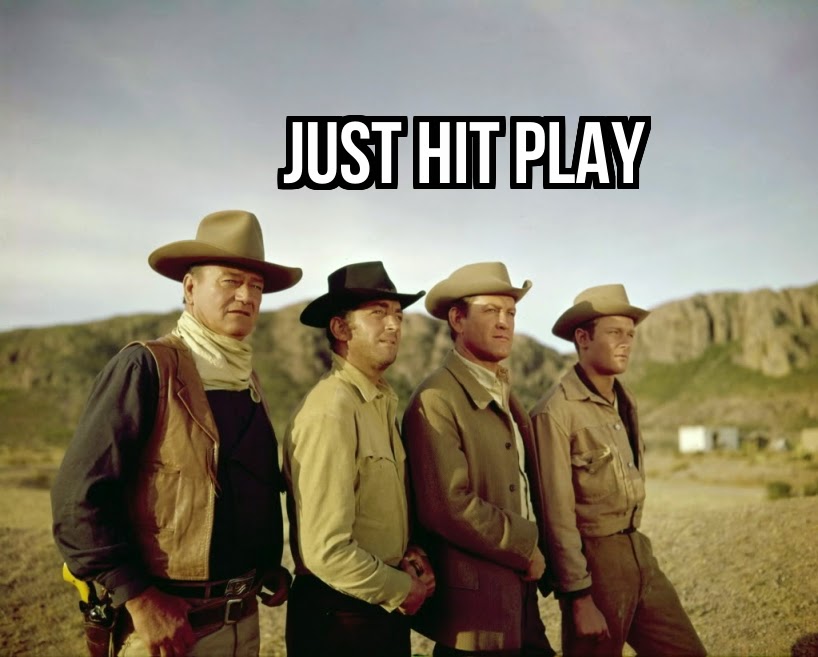All those things were bouncing around in my head as I watched 1949's Task Force this week. It tells the partial story of the development of carriers in the Navy and their involvement with pilots and aviation to advance the Navy's capabilities. They started off as basically sailing airfields on the oceans where rickety planes could land when necessary and developed into immense, very necessary war machines by World War II. A character mentions early on that when trying to land on the flat top of a carrier deck it looks a lot like a tombstone with your name on it, the ship bucking and rolling with the sea. The movie is certainly informative about the subject, but it's missing something, and I wish I could give it a higher rating.
As a young pilot in the Navy, Jonathan Scott (Gary Cooper) is among the first pilots to be trained in carrier landings. Through all the difficulty in this extremely dangerous training, he sees the benefits of a plane being able to land on a ship as it sails across the ocean, and the Navy has a convert. The higher-ups in the Navy don't see the benefit a carrier would have weighed against the huge costs and risks involved. With help from his commanding officer, Capt. Pete Richard (Walter Brennan), Scott continues to work toward the development of carrier task forces in the U.S. Navy, often causing ripples when he should sit back and shut up. Aided on the home front by his wife, Mary (Jane Wyatt), Scott continues on as the Navy continues to develop, unknowingly working toward the coming conflict in WWII where carriers will play a key role in the Pacific theater.
I'll say this first so no one accuses me of hating America or anything similar, but I do like Gary Cooper. I don't love him though. So many of his parts are so bland, so vanilla, that I don't consider myself a huge fan of his. I've never avoided a movie of his because I saw his name and thought 'Hey, that guy sucks!' but at the same time I don't always seek him out. His part here as Capt. Jonathan Scott falls somewhere in the middle of the movies I've seen with him. It's not a particularly lively performance, and he comes across as a bit too whiny for my liking. He has some good interactions with Brennan (solid as ever) and his marriage with Wyatt's Mary doesn't feel as out of place as so many other armed forces marriages in movies, but something's just missing overall in the movie, and that's not a criticism of Cooper or his acting.
All I can wrap my head around is that this movie is basically a documentary about the history of the Navy carrier, but instead of a voiceover provided we get actors stepping into the roles. If anything, Cooper's part is the tour guide, navigating the viewer through this story. He does provide a voiceover of how things are changing for the Navy, but it becomes tedious. If I wanted to watch a history of the U.S. Navy, I'd turn on the History Channel and get caught up with a better made documentary about the subject. As is typical with these movies, a title card thanks the Navy for all their help in making the movie, and cynical guy that I am I couldn't wonder how much control the government and the armed forces had in what the story did and didn't cover. As for Cooper's part, it's a lose-lose battle for him in a part that could have been filled by any cookie-cutter actor.
What saves the movie late is the depiction of the Navy in the days, weeks and months following the sneak attack on Pearl Harbor December 7th, 1941. Pearl Harbor and the battle of Midway are both covered in detail in the movie's last 45 minutes. The problem is though that no matter how good these segments are, there are whole movies devoted to these stories (1976's Midway is a personal favorite) that cover the subject better. Still, that's not a fair criticism of Task Force because director Delmer Daves is doing what he can with what's in front of him. It's easy to forget now some 70 years later, but the course of the war changed at Midway, and if the U.S. had lost that battle WWII might have gone a very different route. As Brennan's character explains, 'The west coast better be ready to fight on the beaches.' One of the darker times in American history, and one where the armed forces came through in a must-win situation.
This isn't a bad movie at all, it's just not a great movie either. It certainly has some potential with an interesting story, but it focuses on trying to tell too big of a story instead of keying in on the most interesting parts of the story. The movie on the whole lacks any real heart, any reason for us to get invested with the story and its characters. It is informative but not very exciting in getting its info out. Worth watching for WWII buffs probably.
Task Force <---trailer (1949): ** 1/2 /****



